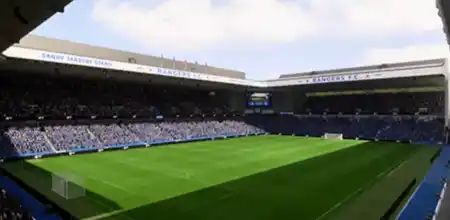Ibrox Stadium
| Official Stadium Name | Ibrox Stadium |
| Former Names | Ibrox Park (1899–1997) |
| Alternative Names | |
| Inauguration Date | 30/12/1899 |
| Opening Game | Rangers |
| Opening Game Date | 30/12/1899 |
| Attendance Record | 118567 |
| Record Match | Rangers |
| Record Date | 02/01/1939 |
| Renovations | 1928, 1978-1981, 1990-1991 |
| Design | Archibald Leitch (1928) The Miller Partnership (1978–1981) Gareth Hutchison (1990–1991) |
| Cost | |
| Owner | Rangers FC |
| Operator | |
| Tenants | |
| League | |
| Pitch Dimension | 105x68 meters |
| Surface |
In-Game Details
In-Game Video
Real Video
Stadium History
Before Rangers moved to Ibrox in 1899, they played on a neighboring pitch for over a decade. Ownership issues led them to purchase the nearby plot, prompting a change in the club’s legal status and the sale of shares to raise funds for a new ground. Unfortunately, the initial wooden structure proved weak, resulting in a tragic incident in 1902, where 25 people lost their lives and 517 others were injured when the highest rows of terracing collapsed.
Renovations took place over the next 15 years, with a major revamp occurring in 1929, including the construction of a new main stand designed by Archibald Leitch. Ibrox Stadium remained relatively unchanged for decades, featuring an oval shape and terracing on artificial hills, forming a vast bowl that could accommodate an astonishing 139,940 fans.
However, a complete makeover was undertaken in the 1970s and 80s after a second tragedy in 1971, where a major crush at one of the staircases claimed 66 lives. The bowl structure was torn down, and three freestanding grandstands were built in its place, significantly reducing standing room and increasing seating capacity to around 44,000. Further modifications in the 1990s set the capacity just above 51,000, with the main grandstand accommodating over 21,000 seats.

 Cinch Premiership
Cinch Premiership

 Sunny
Sunny Snow
Snow Rainy
Rainy Cloudy
Cloudy




